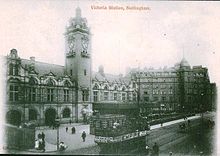Nottingham Corporation Tramways

Tram passing Nottingham Victoria Railway Station
|
|
| Operation | |
|---|---|
| Locale | Nottingham |
| Open | 1 January 1901 |
| Close | 5 September 1936 |
| Status | Closed |
| Infrastructure | |
| Track gauge | 1,435 mm (4 ft 8 1⁄2 in) |
| Propulsion system(s) | Electric |
| Statistics | |
| Route length | 25.9 miles (41.7 km) |
Nottingham Corporation Tramways was formed when Nottingham Corporation took over the Nottingham and District Tramways Company Limited, which had operated a horse and steam tram service from 1877.
In the early part of the year a deputation from Nottingham Corporation visited the cable-operated tramway system at Edinburgh and the overhead electric systems at Bristol and Dover, with the result that on 28 March the Tramways Committee recommended to the City Council that the proposed electric tramways should be operated on the overhead electric system. At an estimated cost of £425,000 (equivalent to £42,700,000 in 2015),, electric tramways were proposed as follows:
Powers for these were granted in the Nottingham Corporation Act 1899.
Certain fare reductions were made during March and, as a result, the bus service connecting the Basford tram service with Bulwell was curtailed at Bulwell Market Place. Suggestions for a bus service to Sneinton were turned down, but in October, following further representations, a service was instituted between Thurland Street, near the Market Place, and Carlton Road Brickyard via Pelham Street, Hockley and Sneinton Street. Six buses were purchased second-hand from Glasgow for this service. The service immediately attracted competition and three privately owned buses commenced operation over the route within a few days of its inception.
On 1 February, J. Aldworth commenced office as Tramways Manager, a position he was to hold for 30 years. Previously he had been Manager of the Douglas, Isle of Man, Tramways, and he succeeded A. Baker on the latter being appointed Chief Officer of the London County Council Tramways.
A further investigation into car design, type of traction and the method of current collection was made by the City Engineer and the Electrical Engineer during a visit to New York and Boston. They confirmed that the overhead electric system would have to be used, although the conduit current collection system was preferable. Tenders were invited from Westinghouse and Dick, Kerr & Co. for cars, and that of Dick, Kerr & Co. for 12 cars was accepted.
Four buses were purchased for £130 (equivalent to £13,000 in 2015) each to replace old ones operating on the Carlton Road and Musters Road services.
Dick, Kerr & Co. informed the Department in January that unless the cars were ordered at once it would not be able to supply them before 1902 and then only at a higher price, and consequently an order was placed for 25. The relaying of the Carrington route with heavier rails (107 lb to the yard girder rails laid on six inches of concrete) and the extension to Winchester Street, Sherwood, began on 1 June. Work on the Sherwood Depot had commenced some weeks previously.
...
Wikipedia
